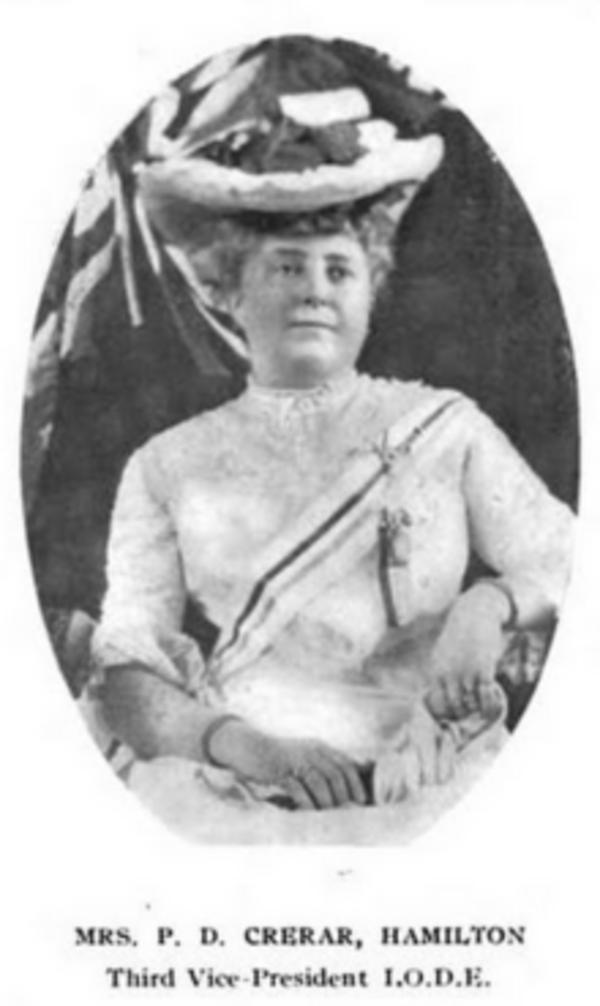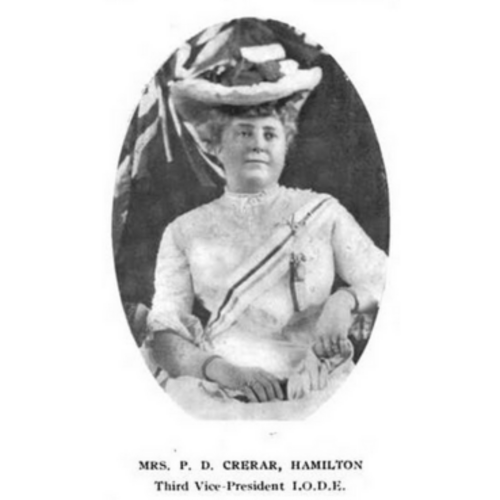
Source: Courtesy of Wikimedia Commons
STINSON, MARION ELIZABETH (Ottaway; Crerar), philanthropist and war worker; b. 8 Sept. 1859 in Hamilton, Upper Canada, daughter of John Stinson, a banker, and Emma Caroline Counsell; m. first 19 Aug. 1877 Cuthbert John Ottaway in Hamilton, and they had a daughter; m. there secondly 9 June 1884 Peter Duncan Crerar, and they had three sons and a daughter; d. there 20 May 1919.
Marion Stinson’s life was shaped by a combination of privilege and pain. Her grandmother Margaret Stinson [Zimmerman] was descended from Pennsylvania Dutch loyalists. Her grandfather Thomas Stinson had emigrated from Ireland and achieved prominence as a merchant banker in Hamilton. His success provided the family with education and status, but this well-being was marred by the premature deaths of six of the family’s nine children, including Marion’s father. The influence on Marion of Margaret Stinson’s stoic example in the face of adversity was marked.
Marion’s father was claimed by tuberculosis in 1865 and her mother remarried three years later. Soon after, her education at local private schools complete, Marion was sent to school in England. Travel and education, according to an obituary, produced a self-assured “woman of the world, cultured, broadminded and possessed of all the social graces.” In 1878 she and her fiancé, a product of Eton and Oxford and a respected lawyer, came back briefly to Hamilton to marry. The following year he died in London of “tubercular trouble,” leaving the 18-year old Marion with an unborn child. A devoted Anglican, she found solace in her church.
Marion returned to Hamilton where, in 1884, she married P. D. Crerar, a Scottish immigrant with a thriving law practice and growing business connections. Together they became a force on Hamilton’s social, cultural, and economic scenes, supporting local theatre and entertaining visiting players. Trained as a singer, Marion regularly attended the opera and raised funds for the philharmonic orchestra. Her attention, however, was mainly devoted to their children, the eldest of whom was Henry (Harry) Duncan Graham*, later the commander of the 1st Canadian Army during World War II. The family travelled abroad and summered in Muskoka. Marion, wrote one admirer, was “a lovely and gracious mother of the older school of life and manners.” Duty to monarch, country, and God were the main tenets of her life.
Practical patriotism marked Marion Crerar’s philanthropic endeavours. Imperial sentiments engendered by the South African War, rather than sympathy for the goals of suffragist reformers, drew her from the home. A founder of the Hamilton branch of the Imperial Order Daughters of the Empire in 1900 [see Edith Sarah Louisa Boulton], she set the chapter’s course as vice-regent from 1900 and as regent from 1902 to 1919, except for a hiatus due to illness in 1913–14. Under her direction the branch staged a “Made in Canada” exhibition in 1903 and a “Made in Hamilton” fair three years later. Guided by her, Hamilton’s IODE also joined the battle against tuberculosis. “No work more practically patriotic,” noted one of Marion’s obituaries, “could be undertaken than the fighting of what is one of the insidious foes of national health and well-being.” Family deaths made her efforts both personal and urgent.
Her leadership in public health developed rapidly. In early 1906 she was an original member of the Ladies’ Auxiliary Board of the Hamilton Health Association, then in the process of establishing the Hamilton Mountain Sanatorium for Consumptives. She soon formed a new chapter of the IODE to provide linens for it. The health association was an umbrella group that essentially handled finances and approved decisions made by the auxiliary board. As the board’s president until her death, Marion led its executive in the operation of the sanatorium. In addition, her family donated a recreational centre, and she inspired her daughter Lillian Beck [Ottaway] and son-in-law Adam Beck*, whose own daughter developed tuberculosis, to found a sanatorium near London, Ont. In all her endeavours Marion was supported by her husband; his death from a stroke in 1912 devastated her and contributed to a decline in her health.
With the outbreak of World War I, Marion Crerar directed her energies towards the war effort. She initially channelled her activities through the IODE, sponsoring lectures to raise money for the troops and using her exceptional organizational abilities in recruiting campaigns and other drives. In September 1915 she donated her home for use as a convalescent hospital by returned soldiers from Hamilton. Operating it independent of the Military Hospitals Commission until its closure in November 1918, she refused any financial support save charitable donations and a dollar a day per patient from Hamilton City Council. “As long as my strength is spared,” she wrote in response to offers of support from the Department of Militia and Defence, “I am glad to do this for my war work and . . . for King and country.” Her sacrifices extended to her family: her sons, Harry, Alastair John, and Malcolm Charlton, all enlisted. Consequently, she organized the Women’s Auxiliary of the 11th Battery, Canadian Field Artillery, Harry’s unit. When Malcolm was killed in the Royal Flying Corps in 1917, she redoubled her efforts. She worked with the Canadian Red Cross Society and, through the IODE, opened and staffed a diet kitchen during the influenza epidemic of 1918–19. Severe wounds suffered by Alastair in 1918 aggravated her failing condition. She resigned as regent in March 1919 and died in May of complications related to diabetes.
“She regarded life as a pilgrimage,” noted the president of the Hamilton Health Association after her death. “I have never before seen such a living sermon,” her spiritual adviser observed. A community leader in public works and imperial sentiment, Marion Crerar epitomized the upper-class social reformer at the turn of the century. Her reformist tendencies, however, grew as much from personal experience as from class.
Family information was graciously supplied to the author by Margaret Crerar Palmer, a granddaughter of the subject, in an April 1991 interview.
HPL, Arch. files, Martin papers, 371; Clipping files, Hamilton – social life and customs. NA, MG 30, E157, 16, 29; RG 24, 4290, file 34-1-54, pt.2. Royal Military College of Canada Library, Special Coll. Div. (Kingston, Ont.), Crerar coll., Crerar family album, 1898–1911. Daily Times (Hamilton, Ont.), 30 June 1865, 6 Aug. 1868. Globe, 27 May 1911. Hamilton Herald, 2 Dec. 1892, 21 Nov. 1908, 10 June 1912, 20 May 1919. Hamilton Spectator, 10 June 1884, 8 Aug. 1917, 20 May 1919. Canadian men and women of the time (Morgan; 1912). DHB, vols.1–2. Marjorie Freeman Campbell, A mountain and a city: the story of Hamilton (Toronto and Montreal, 1966). L. M. Shaw, “Two Hamilton families,” Western Ontario Hist. Notes (London), 16 (1960), no.1: 10–18. Jeffrey Wollock, “Glimpses at a Hamilton family,” OH, 64 (1972): 105–15.
Cite This Article
Paul Dickson, “STINSON, MARION ELIZABETH (Ottaway; Crerar),” in Dictionary of Canadian Biography, vol. 14, University of Toronto/Université Laval, 2003–, accessed January 20, 2025, https://www.biographi.ca/en/bio/stinson_marion_elizabeth_14E.html.
The citation above shows the format for footnotes and endnotes according to the Chicago manual of style (16th edition). Information to be used in other citation formats:
| Permalink: | https://www.biographi.ca/en/bio/stinson_marion_elizabeth_14E.html |
| Author of Article: | Paul Dickson |
| Title of Article: | STINSON, MARION ELIZABETH (Ottaway; Crerar) |
| Publication Name: | Dictionary of Canadian Biography, vol. 14 |
| Publisher: | University of Toronto/Université Laval |
| Year of revision: | 1998 |
| Access Date: | January 20, 2025 |



